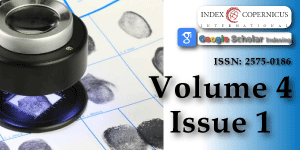Sensitivity and Intertextile variance of amylase paper for saliva detection
Main Article Content
Abstract
Contemporary forensic science hinges on DNA analysis to link an individual to a crime scene. Sources of DNA include bodily fluids, including saliva. Amylase is a primary enzyme in human saliva and thus, if detected, indicates possible presence of human saliva. Amylase paper can be used to map apparent saliva and thus provide a source from which DNA can be extracted and analyzed. In this study, the sensitivity of amylase paper was tested, firstly, using dilutions of an amylase standard and subsequently also tested using fresh human saliva. Three trials total were conducted, the first two using an amylase standard and a third using fresh saliva. The first two trials demonstrated firstly that detection of amylase is dependent on the material upon which amylase is deposited. The third trial demonstrated that amylase levels in human saliva may drop significantly somewhere around 48-72 hours. All trials were consistent in the concentration of amylase that Seratec Amylase Paper will detect.
Article Details
Copyright (c) 2020 Lotozynski A.

This work is licensed under a Creative Commons Attribution 4.0 International License.
Mendel AL, Peyrot des Gachons C, Plank KL, Alarcon S, Breslin PAS. Individual differences in AMY1 gene copy number, salivary α-amylase levels, and the perception of oral starch. PLOS ONE. 2010, 5: e13352. PubMed: https://www.ncbi.nlm.nih.gov/pubmed/20967220
Virkler K, Lednev I. Analysis of body fluids for forensic purposes: From laboratory testing to non-destructive rapid confirmatory identification at a crime scene. Forensic Sci Int. 2009, 188: 1-3. PubMed: https://www.ncbi.nlm.nih.gov/pubmed/19328638

